
Back to Loco of the Month homepage
Back to Sidestreet Bannerworks
.
March 2007
Archangel's The Princess 0-4-0T
by Marc Horovitz

The Princess (later just Princess) was one of four locomotives supplied to the Ffestiniog Railway in Wales in 1863-64. It was designed by C.M. Holland and built by George England & Co. in 1863. When first built, it weighed 7.5 tons. It was rebuilt two or three times, ending up with a large saddle tank. It finally left service in 1946.
The engine
Archangel's model of The Princess is almost a parody of the full-size engine. The prototype was a tiny thing, with a wheelbase of 4'6". This model has a wheelbase of 6'4" in 16mm scale. While the prototype was small and delicate in appearance, the model at hand is a sort of large and hulking caricature of the original. (Compare this engine with Robin Gosling's accurately scaled model of The Prince, a similar locomotive.) Other versions of The Princess were also produced by Archangel, as portrayed in Peter Dobson's book, 16mm Scale Live Steam Model Locomotives. Vol. 1 (there never was a Vol. 2, alas).
Despite its proportions, the model has many interesting points. I acquired it as a disreputable box of bits from a friend at a train show a while back, and went through the enjoyable process of repairing and reassembling the locomotive. It is relatively early Archangel, having been made in 1976. It has cast-iron wheels, which were evidently intended for an 0 scale, standard-gauge engine. Details include dummy outside cylinders, a pair of sand boxes flanking the smokebox, the wonderful hemispherical dome, and the suggestion of a cab front. Name plates were made by stamping the letters into a piece of brass, then riveting them to the dummy side tanks. The builders "plates" are merely paper stickers. The engine begins and ends with a pair of dumb buffers made of wood.
Mechanically, this is an interesting locomotive. It is Archangel's common single-cylinder job. However, because of the forward placement of the front axle, there was not room for the cylinder between the frames. So instead of occupying its usual place, the cylinder was reversed and placed between the two axles towards the rear, driving the first axle by means of an amazingly short rod. Reversing is by slip eccentric.
In the open cab is a throttle, the lever of which conveniently extends past the back plate. There is also a pressure gauge, a blowdown / vacuum tap, and a whistle, the latter of which is actuated by Archangel's nearly impossible whistle valve. The whistle isn't mounted to anything -- it just sort of hangs off its own steam line. The lubricator is fitted with a drain screw and a huge, unsightly filler screw (which, I've been assured, is original equipment!). The lubricator, as well, is not attached to anything but the steam line -- it just floats in the air a few millimeters above the deck.
The Princess is an alcohol burner, the tank being carried between the frames at the rear. A three-wick burner heats the boiler, with the wicks contorted around the engine's mechanics. The long asbestos wicks are splayed out at the top.
The run
The last time I'd run this engine was years ago, so I was looking forward to doing it again. The snow had finally melted enough to reveal the track, so off we went. I prepared the engine in the usual way, making certain to oil all of the moving parts, which had dried out over the years. I filled the tank with alcohol, discovering that the overflow pipe was set too high inside the tank, which caused a fair amount of spillage. I lit the engine on the bench, then carried it to the track, setting it on a low concrete bridge. Flaming alcohol immediately dripped out, setting the dried grasses below alight. I moved the engine onto solid ground and extinguished the growing forest fire. Once the fuel level dropped a bit, all was well.
It was a cool day, with the temperature in the low 40s, so it took a little while for steam to come up. Once it did, I opened the throttle, and the engine moved right off without a stutter. Because of the cylinder's close proximity to the fire, it was already hot, so there was no condensate.
I backed the loco up and coupled it to a train of 10 four-wheel wagons, then turned it loose on the mainline. The scruffy-looking engine, its paint peeling off in several places, ran beautifully. Its characteristic two-chuffs per revolution were clearly audible. The safety valve blew noisily at around 80 pounds, sending a fine plume of steam into the cold air. Around and around it went, with only the occasional stop for more fuel. It is a very thirsty engine and the fuel tank required relatively frequent topping up, even with its large reservoir. It was easy to control and docile in manner, pulling its train with nary a complaint. It could easily have taken a much larger load.
After perhaps 40 minutes (I didn't time it), with the setting sun shining dimly through the high clouds and the temperature dropping, I let the fire die and ran the train into the station on residual steam. Thus ended a run that could only be described as spectacular.
|
|
|
| Builder | Archangel (UK) |
| Date built | 1976 |
| Gauge | 0 (32 mm) |
| Scale | 16mm |
| Boiler | Pot |
| Fittings | Safety valve, throttle, blowdown valve, whistle |
| Fuel | Alcohol |
| Blow-off pressure | 70-80 psi |
| Cylinders | One, double-acting D-valve |
| Reversing gear | Slip eccentric |
| Lubricator | Displacement |
| Weight | 5 pounds, 8 ounces |
| Dimensions | Length over end beams, 10-7/8"; width, 4-1/8"; height over stack, 6" |
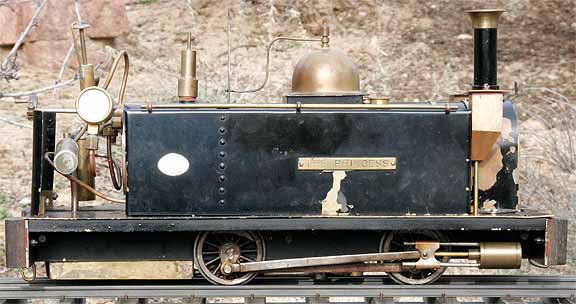
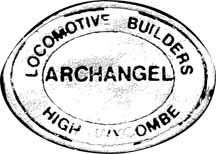
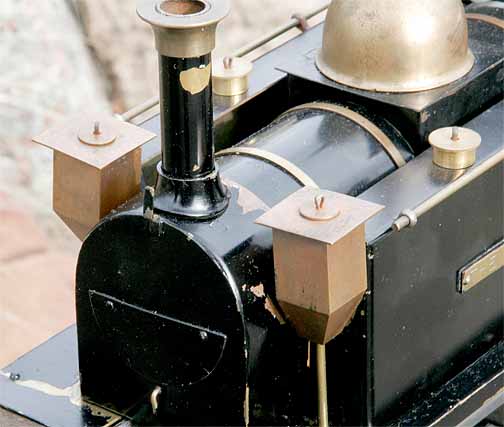
When first acquired, the boiler, which is hung from a single screw behind the smoke stack, was pushed down, deforming the copper smokebox. This had to be straightened and the boiler reattached, which accounts for some of the paint loss.


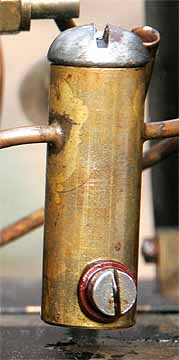
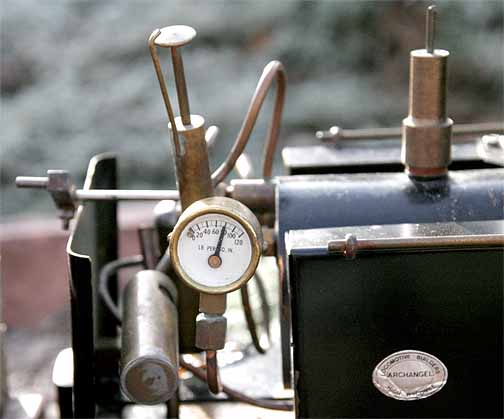
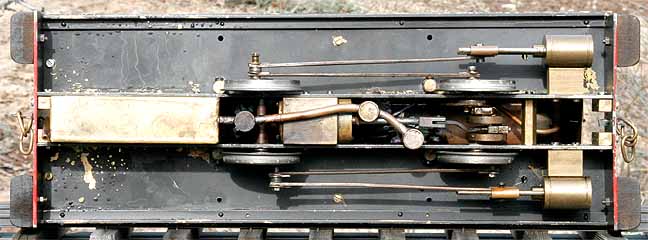

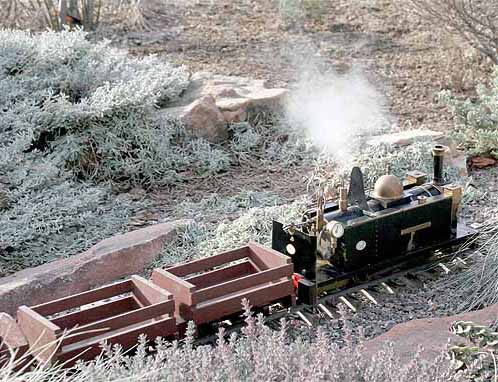


Back to Loco of the Month home page
Back to Sidestreet Bannerworks home page
This page and its contents
Copyright Sidestreet Bannerworks, 2006
.